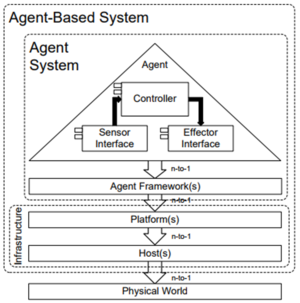Agent Systems Reference Model (ASRM)
The agent systems reference model (ASRM) is a layered, abstract description for multiagent systems. As such, the reference model
- provides a taxonomy of terms, concepts and definitions to compare agent systems;
- identifies functional elements that are common in agent systems;
- captures data flow and dependencies among the functional elements in agent systems; and
- specifies assumptions and requirements regarding the dependencies among these elements.
The ASRM differentiates itself from technical standards, such as Knowledge Interchange Format, Knowledge Query and Manipulation Language, and those of the Foundation for Intelligent Physical Agents in that it defines the required existence of components of a multiagent system; standards prescribe how they are designed.[1]
The ASRM provides a model for software systems composed of agents. It establishes terms, concepts, and definitions required to compare agent systems. The ASRM defines an intelligent agent - or simply agent - as situated computational processes that embody one or more of the following qualities: autonomy, proactivity, interactivity, continuous, sociality, and/or mobility. The ASRM also formalizes concepts and layers of organization in an agent-based system. The layers are: agents, frameworks, platforms, hosts, and environments. An agent-based system is the set of frameworks, the agents that execute in them, the platform (other software) that supports them and the hosts (hardware) upon which they execute. The ASRM describes an agent system as a set of abstract functional concepts that support overall system execution. The functional concepts represent the complex interactions between software and hardware located at different layers of the agent system. The functional concepts are as follows:
- Agent Administration facilitates and enables command and control of agents and allocates resources to those agents as needed.
- Security and Survivability prevents execution of undesirable actions within an agent system while allowing execution of desirable actions.
- Mobility facilitates and enables the migration of agents among framework instances (typically, but not necessarily, on different hosts)
- Conflict Management facilitates and enables the management of interdependencies between agents activities and decisions.
- Messaging facilitates and enables information and data transfer among agents in the system.
- Logging facilitates and enables information about events to be recorded occurring during system execution for subsequent inspection.
- Directory Services facilitates and enables the locating and accessing of shared resources.[2]
Abstract model of an Agent System.(See Illustration Below)
Such systems decompose into several layers of hardware and software that provide an operating context for agents, situated computational process that sense and affect their environment. Note that the relationships across layers may be n-to-1.

source: FIPA.org
Applicability of Agent Systems Reference Model (ASRM) [3]
The ASRM is applicable to existing agent frameworks and will be applicable to all those in the future, as well. The ASRM is designed by extracting commonalities between existing frameworks
and by applying existing agent research. The ASRM provides a common ontology for agent frameworks. Previous systems benefit from this model since a language is provided for describing
the advantages and disadvantages of each system. Developers of future frameworks will have a blueprint to follow, forming the basis on which all agent systems—past, present, and future—are
compared. System engineering tasks also benefit from the reference model because the information used to construct the model was gathered using both common and specially developed analysis techniques. Previously built systems were analyzed and compared in order to piece together a common model. These techniques are applicable to the analysis of almost any system since they, too, are built piece by piece. The reverse engineering techniques specifically geared towards agent systems can be applied in a similar fashion to other systems. Further, the techniques themselves can be studied and improved. Agent frameworks are very similar to operating systems, so these reverse engineering techniques also apply in this realm. The reference model provides a common ontology, innovative and practical system engineering techniques, and software development guidance. All of these ideas support evolving Agent Frameworks and Application Program Interfaces (APIs) - past, present, and future. If the ASRM is used correctly, the result will be independently developed software agents and agencies capable of interoperating in a heterogeneous environment.
See Also
References
Further Reading
- A Reference Model for Agent-Based Command and Control Systems Christopher J. Dugan, et al.
- Towards a Reference Model for Agent-Based Systems Pragnesh Jay Modi, et al.
- Development and Specification of a Reference Model for Agent-Based Systems IEEE.org
